Abstract
Although the Gram stain and culture of expectorated sputum are considered standard methods for the diagnosis of presumptive pneumococcal pneumonia, these methods remain relatively insensitive and nonspecific. We developed an enzyme immunoassay (EIA) for the quantitation of pneumococcal C polysaccharide (PnC) in the sputum of patients with presumptive pneumococcal pneumonia. Of 34 patient sputum samples collected within 24 h of the first radiographic report of pneumonia, 12 grew Streptococcus pneumoniae on culture. By using a cutoff point of 0.5 micrograms of PnC per ml of sputum, all 12 specimens were positive (sensitivity, 100%) by EIA. PnC levels ranged from 1.43 to 57.53 micrograms/ml. Blood samples from 18 of the 34 patients were cultured. S. pneumoniae grew in the culture of a blood sample from one patient, whose sputum also had the highest PnC level. Of 22 sputum samples from patients with pneumonia that did not grow S. pneumonia, two were positive by EIA (specificity, 90.1%). Sputa from both patients had low levels of PnC (2.7 and 4.5 micrograms/ml), and both patients had received antibiotics before sputum collection. The positive predictive value of the quantitative EIA was 85.7%. Quantitation of PnC has the potential for improving the accuracy of sputum examination for S. pneumoniae, monitoring disease severity and the effectiveness of antibiotic therapy, and differentiating between those patients with invasive pneumococcal disease and those who are carriers of S. pneumoniae.
Full text
PDF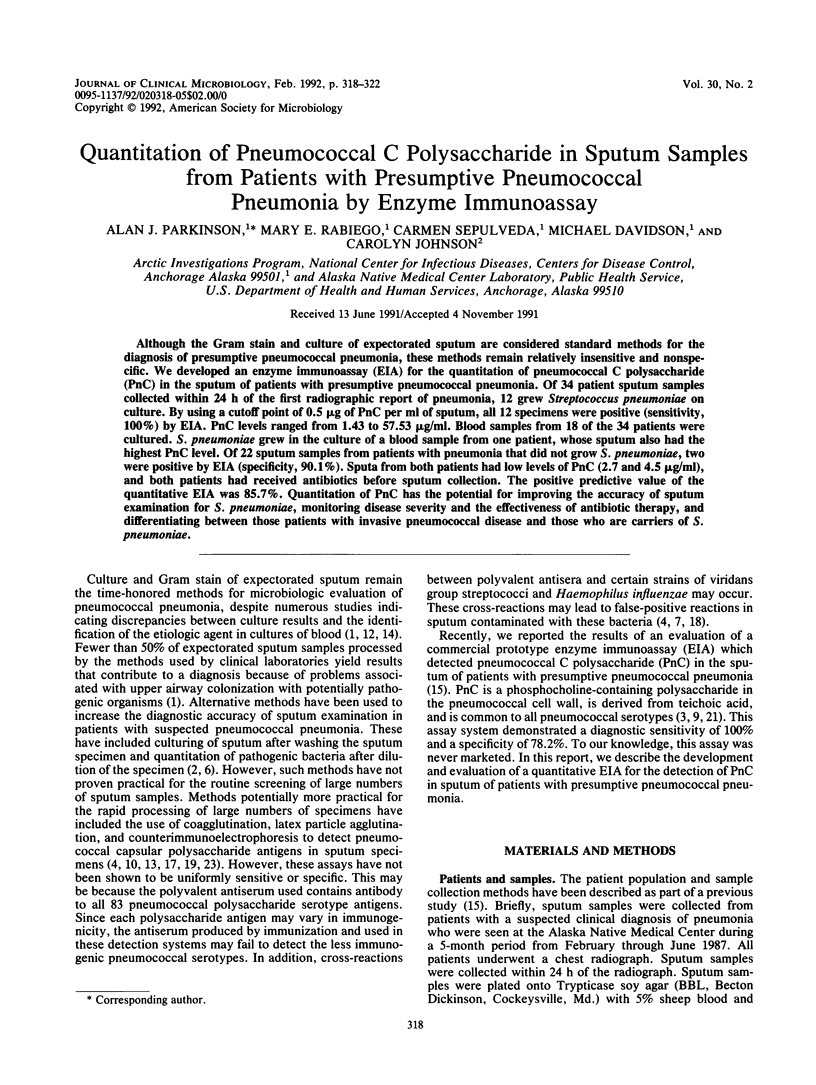
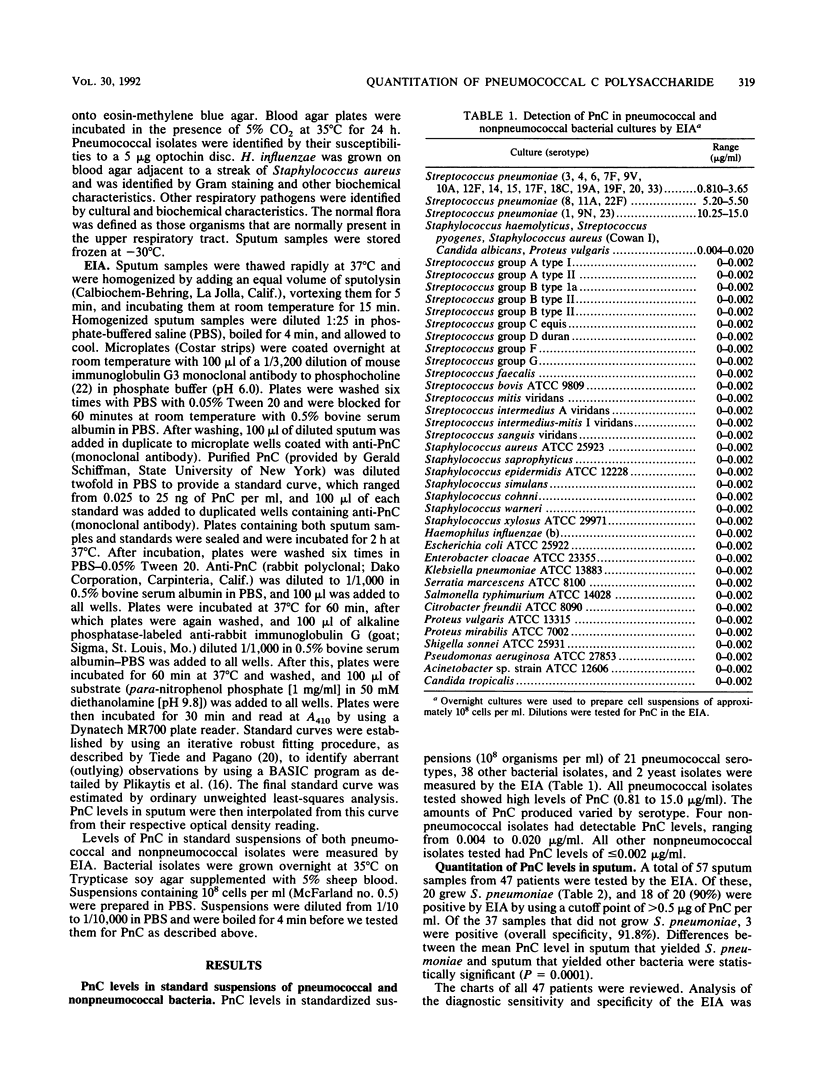
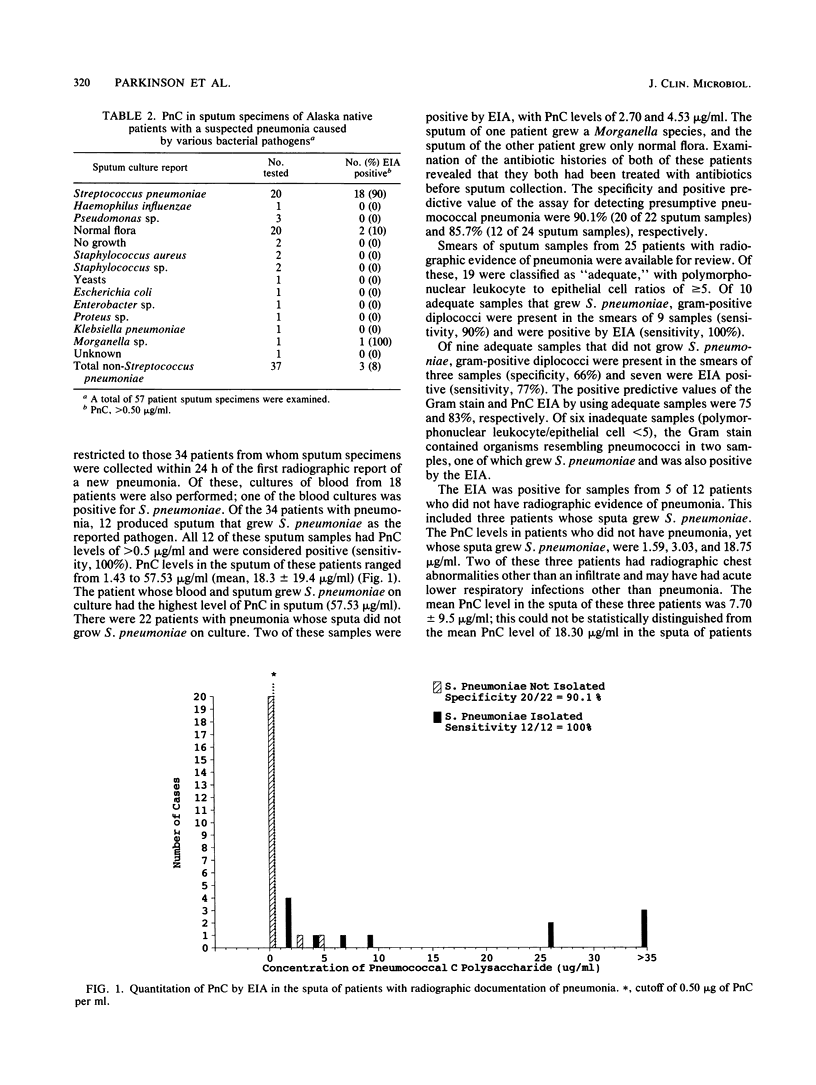
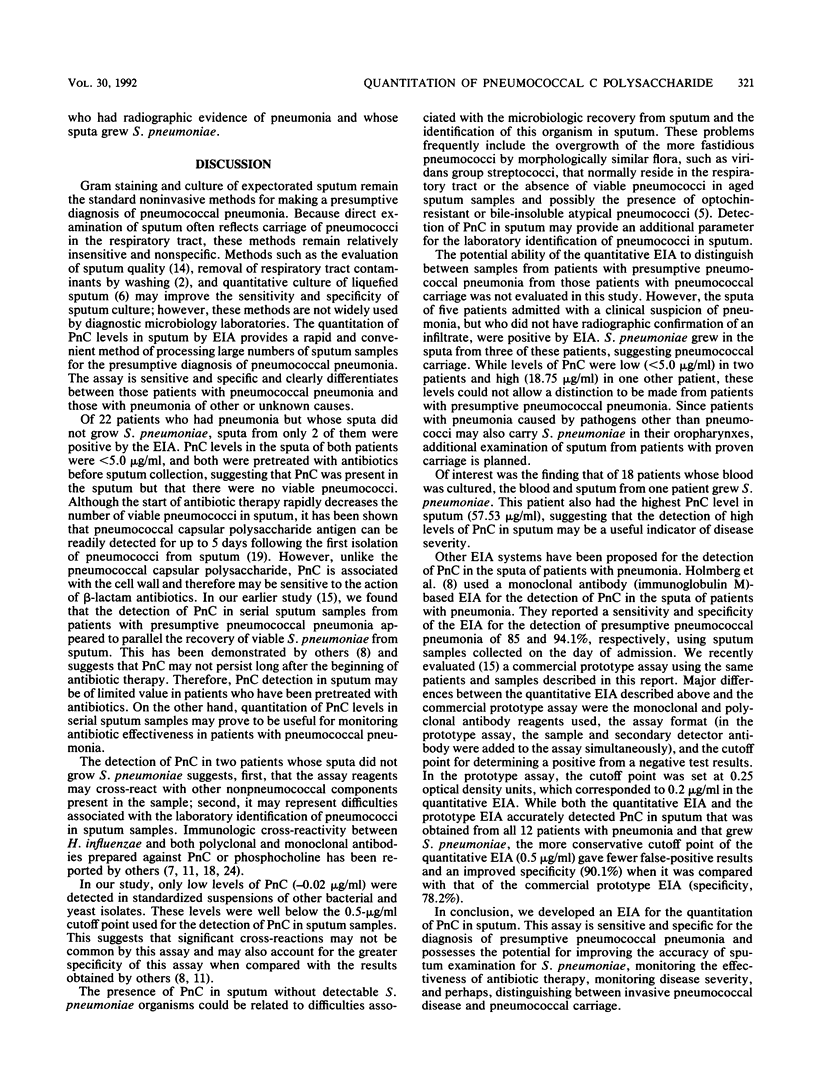
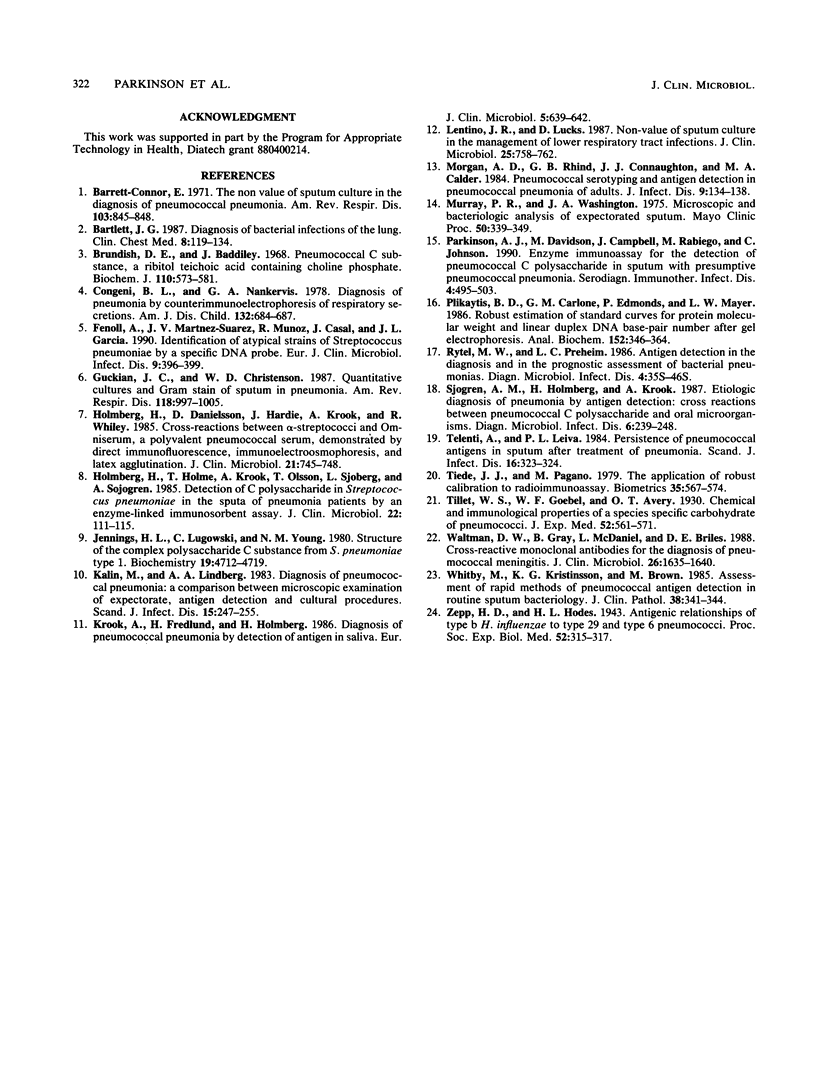
Selected References
These references are in PubMed. This may not be the complete list of references from this article.
- Barrett-Connor E. The nonvalue of sputum culture in the diagnosis of pneumococcal pneumonia. Am Rev Respir Dis. 1971 Jun;103(6):845–848. doi: 10.1164/arrd.1971.103.6.845. [DOI] [PubMed] [Google Scholar]
- Bartlett J. G. Diagnosis of bacterial infections of the lung. Clin Chest Med. 1987 Mar;8(1):119–134. [PubMed] [Google Scholar]
- Brundish D. E., Baddiley J. Pneumococcal C-substance, a ribitol teichoic acid containing choline phosphate. Biochem J. 1968 Dec;110(3):573–582. doi: 10.1042/bj1100573. [DOI] [PMC free article] [PubMed] [Google Scholar]
- Congeni B. L., Nankervis G. A. Diagnosis of pneumonia by counterimmunoelectrophoresis of respiratory secretions. Am J Dis Child. 1978 Jul;132(7):684–687. doi: 10.1001/archpedi.1978.02120320044010. [DOI] [PubMed] [Google Scholar]
- Fenoll A., Martinez-Suarez J. V., Muñoz R., Casal J., Garcia J. L. Identification of atypical strains of Streptococcus pneumoniae by a specific DNA probe. Eur J Clin Microbiol Infect Dis. 1990 Jun;9(6):396–401. doi: 10.1007/BF01979468. [DOI] [PubMed] [Google Scholar]
- Guckian J. C., Christensen W. D. Quantitative culture and gram stain of sputum in pneumonia. Am Rev Respir Dis. 1978 Dec;118(6):997–1005. doi: 10.1164/arrd.1978.118.6.997. [DOI] [PubMed] [Google Scholar]
- Holmberg H., Danielsson D., Hardie J., Krook A., Whiley R. Cross-reactions between alpha-streptococci and Omniserum, a polyvalent pneumococcal serum, demonstrated by direct immunofluorescence, immunoelectroosmophoresis, and latex agglutination. J Clin Microbiol. 1985 May;21(5):745–748. doi: 10.1128/jcm.21.5.745-748.1985. [DOI] [PMC free article] [PubMed] [Google Scholar]
- Holmberg H., Holme T., Krook A., Olsson T., Sjöberg L., Sjögren A. M. Detection of C polysaccharide in Streptococcus pneumoniae in the sputa of pneumonia patients by an enzyme-linked immunosorbent assay. J Clin Microbiol. 1985 Jul;22(1):111–115. doi: 10.1128/jcm.22.1.111-115.1985. [DOI] [PMC free article] [PubMed] [Google Scholar]
- Jennings H. J., Lugowski C., Young N. M. Structure of the complex polysaccharide C-substance from Streptococcus pneumoniae type 1. Biochemistry. 1980 Sep 30;19(20):4712–4719. doi: 10.1021/bi00561a026. [DOI] [PubMed] [Google Scholar]
- Kalin M., Lindberg A. A. Diagnosis of pneumococcal pneumonia: a comparison between microscopic examination of expectorate, antigen detection and cultural procedures. Scand J Infect Dis. 1983;15(3):247–255. doi: 10.3109/inf.1983.15.issue-3.04. [DOI] [PubMed] [Google Scholar]
- Krook A., Fredlund H., Holmberg H. Diagnosis of pneumococcal pneumonia by detection of antigen in saliva. Eur J Clin Microbiol. 1986 Dec;5(6):639–642. doi: 10.1007/BF02013288. [DOI] [PubMed] [Google Scholar]
- Lentino J. R., Lucks D. A. Nonvalue of sputum culture in the management of lower respiratory tract infections. J Clin Microbiol. 1987 May;25(5):758–762. doi: 10.1128/jcm.25.5.758-762.1987. [DOI] [PMC free article] [PubMed] [Google Scholar]
- Morgan A. D., Rhind G. B., Connaughton J. J., Calder M. A. Pneumococcal serotyping and antigen detection in pneumococcal pneumonia of adults. J Infect. 1984 Sep;9(2):134–138. doi: 10.1016/s0163-4453(84)90961-7. [DOI] [PubMed] [Google Scholar]
- Murray P. R., Washington J. A. Microscopic and baceriologic analysis of expectorated sputum. Mayo Clin Proc. 1975 Jun;50(6):339–344. [PubMed] [Google Scholar]
- Plikaytis B. D., Carlone G. M., Edmonds P., Mayer L. W. Robust estimation of standard curves for protein molecular weight and linear-duplex DNA base-pair number after gel electrophoresis. Anal Biochem. 1986 Feb 1;152(2):346–364. doi: 10.1016/0003-2697(86)90420-3. [DOI] [PubMed] [Google Scholar]
- Rytel M. W., Preheim L. C. Antigen detection in the diagnosis and in the prognostic assessment of bacterial pneumonias. Diagn Microbiol Infect Dis. 1986 Mar;4(3 Suppl):35S–46S. doi: 10.1016/s0732-8893(86)80041-4. [DOI] [PubMed] [Google Scholar]
- Sjögren A. M., Holmberg H., Krook A. Etiologic diagnosis of pneumonia by antigen detection: crossreactions between pneumococcal C-polysaccharide and oral microorganisms. Diagn Microbiol Infect Dis. 1987 Mar;6(3):239–248. doi: 10.1016/0732-8893(87)90018-6. [DOI] [PubMed] [Google Scholar]
- Telenti A., Suarez Leiva P. Persistence of pneumococcal antigens in sputum after treatment of pneumonia. Scand J Infect Dis. 1984;16(3):323–324. doi: 10.3109/00365548409070409. [DOI] [PubMed] [Google Scholar]
- Tiede J. J., Pagano M. The application of robust calibration to radioimmunoassay. Biometrics. 1979 Sep;35(3):567–574. [PubMed] [Google Scholar]
- Waltman W. D., 2nd, Gray B., McDaniel L. S., Briles D. E. Cross-reactive monoclonal antibodies for diagnosis of pneumococcal meningitis. J Clin Microbiol. 1988 Sep;26(9):1635–1640. doi: 10.1128/jcm.26.9.1635-1640.1988. [DOI] [PMC free article] [PubMed] [Google Scholar]
- Whitby M., Kristinsson K. G., Brown M. Assessment of rapid methods of pneumococcal antigen detection in routine sputum bacteriology. J Clin Pathol. 1985 Mar;38(3):341–344. doi: 10.1136/jcp.38.3.341. [DOI] [PMC free article] [PubMed] [Google Scholar]


